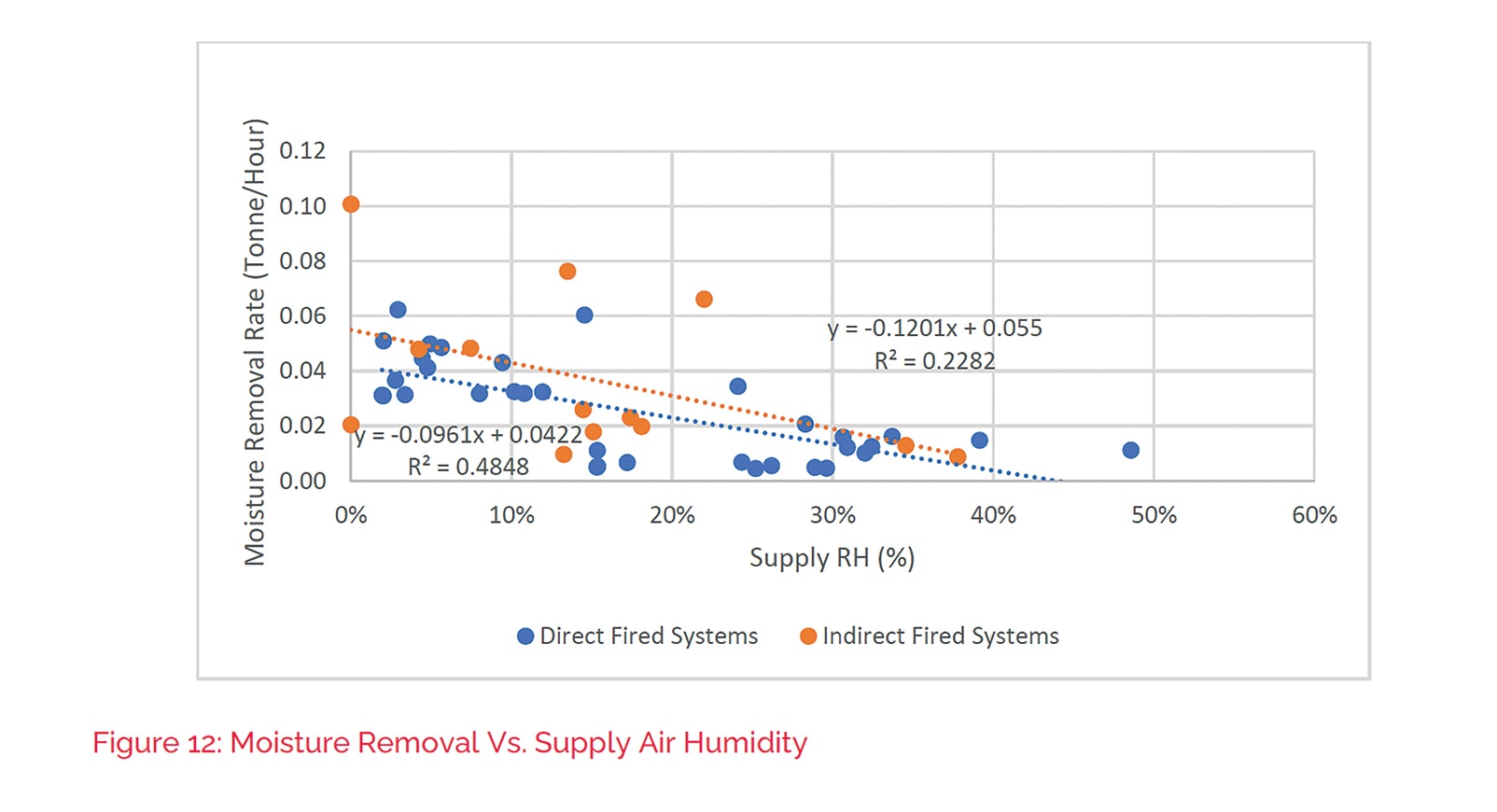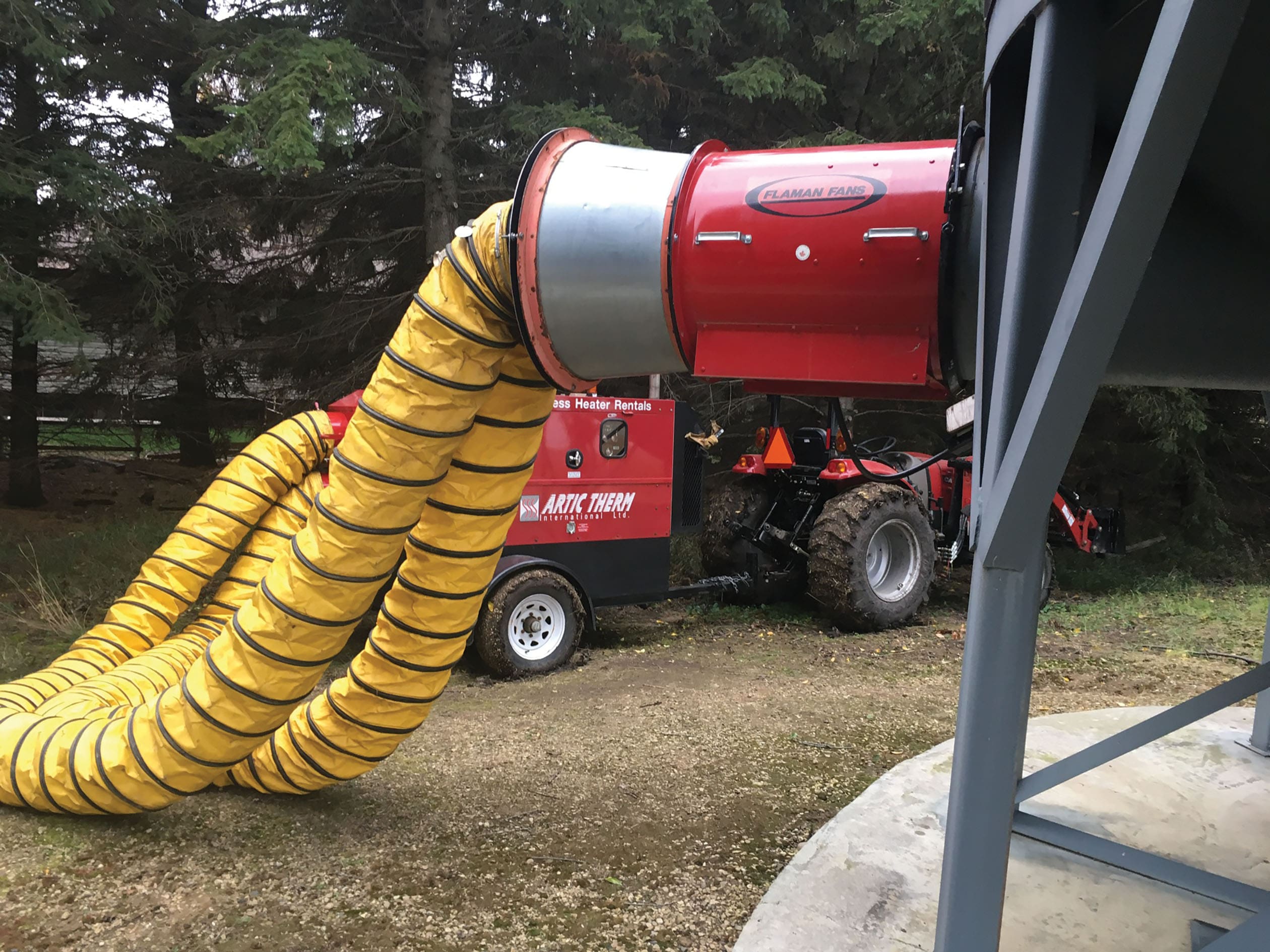How to make in-bin drying more efficient
Alberta farmer Jason Lenz first tried this 500,000 BTU heater, a diesel engine that drives a friction plate to create heat. A fan blows heated air through a 20″ diameter flexible insulated tube, which clamps to the bin fan’s air intake vent.
An Alberta study comparing in-bin drying systems found that indirect heat sources may have a slight efficiency advantage over heaters installed in-line with aeration fans. The reason could be that moist exhaust air is not included in the air supply, which keeps humidity low.
Team Alberta – Alberta Barley, Alberta Canola, Alberta Pulse Growers and the Alberta Wheat Commission – led the 2019-21 study, with funding provided in part through the Government of Canada and Alberta through the Canadian Agricultural Partnership. PAMI provided technical support while 3D Energy collected the data.
Methodology
Cooperating farmers ran their drying and storage systems as they normally would. Farmers recorded grain volume dried, initial grain moisture, final grain moisture and grain temperature.
PAMI and 3D Energy recorded thermal and electrical energy consumption, as well as supply air (plenum) temperature, ambient air temperature, and ambient relative humidity throughout the drying process.
The study analyzed in-bin aeration systems using indirect and direct heaters, and a small sample of continuous dryers. Crops were canola, barley and wheat.
On-farm “business-as-usual” operation of various drying systems created a long list of variables, including outside (ambient) temperature, supplied air humidity, grain moisture, grain type, bin size, fan size, heater type, air input screens, bin-top venting and energy source.
To work around these variables, PAMI and 3D Energy compared systems based on energy use intensity (EUI), expressed as gigaJoules of energy consumed per tonne of moisture removed (GJ/t).
Key results for in-bin drying
Farmers can improve grain drying efficiency with the following observations, which were included in a final report from 3D Energy.
Direct vs Indirect. In-bin systems can get supplemental heat from direct heaters mounted in-line with the fan or indirect heaters that supply heated air through a tube from an external heater. For this study, systems using indirect heat had average energy use of 4.6 GJ/t (range from 2.4 to 8.9) and systems using direct heat had an average energy use of 7.1 GJ/t (range from 3.8 to 18.5). PAMI and 3D Energy report that the sample size is too low to confirm a difference, but indirect heaters do seem to have an advantage. They say it may be due to lower relative humidity of the indirect air because moist exhaust air is not included in the air supply.
Air’s capacity to dry. Air with lower relative humidity has more water holding (and therefore water removing) capacity. Adding heat lowers the relative humidity of incoming air. The report notes that increasing the temperature of the supply air by 30°C can reduce the air’s relative humidity from 100 per cent down to 14-16 per cent, which “increases the drying capacity of the air exponentially.” As an added observation, PAMI and 3D Energy note that relative humidity of ambient outside air is not a major factor when it comes to the efficiency of heated air drying systems.
Hotter air reduces drying time. It takes a lot more energy to heat air to 30°C than to 10°C, but the hotter air also dries grain a lot faster. The increase in fuel consumption closely matches the increase in moisture removal, so that part of the equation is fairly even in terms of energy consumption. However, faster drying means the electric fans don’t have to run as long. This gives hotter air the advantage in terms of overall efficiency, the study concluded. Supply air temperatures for in-bin drying ranged from 13°C to 55°C. The report includes one caution: “Bins utilizing high supply air temperatures should be closely monitored as bins that are too dry can cause excessive shrinkage and reduce profitability, negating any savings.” PAMI and 3D Energy add that more research on supply air temperatures for different grain types and air distribution systems is required.

Target air flow of one cubic foot per minute per bushel (cfm/bu.) Air flow for all systems in the study ranged from 0.65 to 1.20 cfm/bu., which is within sight of PAMI’s recommended 1.0 cfm/bu. Therefore, for systems in this study, air temperature was more important than air flow for moisture removal. Had air flow been well below the optimal target, drying efficiency would be a lot lower. Because canola has a higher static pressure than wheat or barley, farmers can reduce the volume of canola in drying bins to increase air flow, if necessary.
Static pressure. With its smaller seeds, canola has two to 2.5 times the static pressure of barley – which means canola resists air flow to a greater degree. Aeration fans will use more electricity and be less efficient with higher static pressures, however reducing batch size to reduce static pressure will require more batches and longer overall fan run-times. As long as air flow is at around 1.0 cfm/bu., static pressure is not really relevant. Fill grain to a point where airflow is maintained at this range.
Rooftop exhaust fans. For this study, bins with rooftop exhaust fans decreased energy consumption by approximately nine per cent when compared to bins with passive venting.
Keep the burners clean. Dirt and debris within the burner orifice and faulty or inaccurate sensors can affect the air-to-fuel ratio, which reduces performance. “Optimization and proper maintenance of the burners can lead to increased performance,” the report says.
Air ducting. Farmers who participated in the study had a variety of ducting systems and bin types. These included flat-bottom bins with perforated floors, hopper bottoms with rocket ducting, and hopper bottoms with side-wall ducting. The study didn’t report on any major differences in performance based on bin type and ducting. More research is needed to identify differences.
Key results for continuous dryers
This part of the study was smaller and ran into some snags. In total, five natural gas dryers were metered for the study, but not all operated in each of the three years. Average efficiency for each model was similar, ranging from 7.25 to 7.54 GJ/t.
The report concludes, “This suggests that among continuous grain driers, grain condition and environmental factors have a larger effect on drying efficiency than dryer brand or model.”
Energy choices
In all systems, natural gas was the lowest cost heating fuel based on energy used per tonne of moisture removed. Farms that anticipate large volumes of grain drying may want to inquire about a natural gas supply to the bin site. Diesel is the next best option, but it was about four times the price per bushel of grain dried. (Based on 2019 prices, average drying costs were 5¢ per bushel for natural gas systems, 21¢ for diesel and 27¢ for propane. Electricity was similar to propane.) The study concluded that “utilizing electric heating for grain drying should be avoided, as electricity has the highest operating costs and emissions, and would require a large infrastructure investment for service lines and transformers to be capable of the required demand need for grain drying.”
Of course electricity is still needed to run the fans.
Government help for grain drying in Alberta
Alberta’s Efficient Grain Handling Program, funded through the federal government’s Canadian Agricultural Partnership (CAP), was open and accepting applications as of early August but funding was running out. cap.alberta.ca/CAP/program/EGH
Shannon Sereda, senior manager for government relations and policy with Alberta Barley and Alberta Wheat, says the list of eligible on-farm projects has two new items as a result of the Team Alberta grain drying study. They are:
- Pipeline to grain dryer – for costs incurred over and above those paid for by the Rural Gas Program to a maximum of $20,000 per applicant. Important: A quote must be provided by the natural gas provider.
- Indirect-fired high-efficiency portable aeration dryers.
Farmer cooperator: Roger Chevraux, Killam, Alberta
 Roger Chevraux, chair of Alberta Canola, participated in the grain drying study using an in-bin system with direct heat. The 10,000-bushel flat bottom bin had an aeration floor, 10-hp Grain Guard fan and Sukup heater.
Roger Chevraux, chair of Alberta Canola, participated in the grain drying study using an in-bin system with direct heat. The 10,000-bushel flat bottom bin had an aeration floor, 10-hp Grain Guard fan and Sukup heater.
If a farmer has to dry a lot of grain, this is not the ideal system, Chevraux says. With this bin, he can dry only 4,000 bushels at a time, otherwise the statistic pressure gets too high. “With the back pressure, we could not get a clean flame,” he says. “If we put more than 4,000 bushels in the bin, we’d have to take the heaters apart and clean them.”
It takes about three days to dry each 4,000-bushel batch. Then the bin has to be emptied, cleaned and refilled for the next round. After the late harvest of 2018, Chevraux had to dry about 50,000 bushels. He says it felt like he was drying grain all winter.
“It was cumbersome, time consuming and labour intensive,” he says.
Running the bin less than half full also presented a challenge for the study. The researchers asked him to provide moisture updates every couple of days. “It was hard to probe grain in a 10,000 bin that was less than half full,” he says.
Two years ago, Chevraux set up a continuous drying system with a Neco dryer, wet bin, dry bins, and pneumatic transfer from bin to bin. It is wired to keep running automatically, based on the moisture target.
“This system is much easier, and we’re not overdrying as much as we did with the in-bin system that was so difficult to probe,” he says.
The Neco dryer has been especially effective for malt barley. “We can combine it four points above dry, which gets our harvest started a lot quicker and gets us going again just a day or two after rain,” he says. This makes it more likely that the barley will meet malt specifications.
Chevraux’s in-bin system and continuous dryer are both propane powered.
Farmer cooperator: Jason Lenz, Bentley, Alberta
 Jason Lenz, vice chair of Alberta Wheat Commission, participated in the study using an in-bin drying system with indirect heat.
Jason Lenz, vice chair of Alberta Wheat Commission, participated in the study using an in-bin drying system with indirect heat.
Lenz uses a construction flame-less heater. These are often used to heat building construction sites for winter work. A John Deere diesel engine mounted on a single-axle trailer powers a friction plate to generate the heat. The higher the RPMs, the more heat produced. Exhaust is expelled and not used as part of the heat source, but the engine and friction plate are fully enclosed to capture the heat. A fan inside the unit blows heated air through a 20″ diameter flexible insulated tube, which clamps to the bin fan’s air intake vent. He can move the until from one bin to another in less than 20 minutes.
“The best part of it,” Lenz says, “is that the heated air has near zero humidity.”
He rents the heater by the month, as needed. He tried a 500,000 BTU the first time, then switched to a 1,000,000 BTU unit, which works better, he says.
“A farmer from north of Edmonton first started using them, and word spread fast in 2016 and 2017 when we had lots of grain to dry,” he says. Lenz uses the indirect heater on hopper bottom bins with horizontal aeration tubes. He dried wheat and barley in 2016, 2017 and 2019. “It’s pretty easy to get 16-17 per cent moisture grain down to 13 per cent,” he says.
A limitation with in-bin drying systems, Lenz says, “is that you don’t get the grain evenly dried. The bottom grain dries faster, so you need to do a little bit of blending after the bottom stuff gets dry. We auger some out, and add some in as we go.”
He recommends good bin probes and a good moisture tester. “You do a lot of samples to make sure it’s blended right. We did dry some wheat and barley down to nine per cent the first time around,” he says. “Another thing we learned is that the ambient temperature outside makes a difference. If you can dry when outside temperature is above 0°C versus minus 20°C, you’ll be that much more efficient.”
It’s a simple system, he says, and even through diesel is more expensive than natural gas, “we were surprised how efficient it was.”





